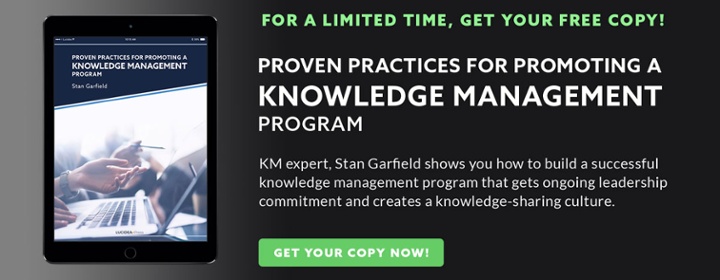
The single most important “KM sale” you can make is to your senior leaders. As mentioned in my previous post on this topic, if you get them on board, everything else will be much easier. If you can’t, you must keep trying until you do. To get their sponsorship and support, tell stories, make the business case, and sell the benefits. Please read on to learn about making the business case, drawn from my new book Proven Practices for Promoting Knowledge Management.
Proven practices for making the KM business case
Make a logical case for how your KM program will help achieve the key business objectives of the organization. For example, if the top three objectives are increasing profits, accelerating sales, and improving customer satisfaction, explain how the elements of the program will have a positive impact on these. If profits increase, sales accelerate, and customer satisfaction improves, and there is a rational explanation for how knowledge management supported these results, then take partial credit. On the other hand, if the business results are not achieved, the assertion that KM is doing well won’t be positively received. You can try to argue that things would have been even worse without KM, but that would be a hollow victory.
Establish plausible scenarios and then extrapolate the benefits. For example:
- If we save one project from repeating the same mistakes as previous projects, that could save $2 million, which will more than pay for the program. If we repeat this, the impact on profits is very large.
- If by responding quickly to an opportunity with a proven solution using acknowledged experts, we win one $10 million project that we otherwise would have lost, that’s incremental revenue of $10 million. If we repeat this, the impact on revenue is very large.
- If by ensuring that the best engineering product knowledge is reused, we avoid one product recall, we save the company hundreds of millions of dollars.
Define the most painful problems that knowledge management can help prevent, such as:
- Product recalls
- Injuries or deaths
- Lawsuits
- Unprofitable products and services
- Low employee morale
- Lost customers
- Damage to the brand
- Inability to attract or retain talent
- Diminished productivity, revenue, growth, profit margin, shareholder value
- Becoming a takeover target
Ask compelling questions to help make a sound business case. For example:
- Do we want to enable people to readily find deliverables from previous projects so that they can reuse them, and identify people who can provide useful advice on how to deliver the next one?
- Do we want anyone who has a question, seeks a resource, or requires help to be able to easily, quickly, and reliably get what they need?
- Do we want to avoid redundant effort, repeating the same mistakes over and over, and keeping important information from reaching the very people who need it?
In addition, work with analytics experts, statisticians, and academicians to produce correlations between desired knowledge-sharing actions and desired results, including employee advancement, project success, and financial performance. Optionally, do a one-time study to show the business benefits. There is often no need for ongoing collection and reporting of ROI, since it has been done once.
Lucidea Press has published my latest book, Proven Practices for Promoting a Knowledge Management Program, which includes additional information on obtaining leadership commitment, and many insights drawn from my career as a KM practitioner.



